
Newer methods such as PRIMA and PVL use implicit moment matching, based on Krylov subspaces. The first use of this technique, AWE, used explicit moment matching. (These are very closely related - see Laplace transform.) It can also be thought of a generalization of Elmore delay, which matches the first moment in the time domain (or computes a one-pole approximation in the frequency domain - they are equivalent). It can be thought of as either matching multiple moments in the time domain, or finding a good rational approximation (a Padé approximation) in the frequency domain. Moment matching is a more sophisticated analytical method.If the network is not tree structured the Elmore delay can still be computed, but involves matrix calculations.) In this case the Elmore delay can be calculated in time O(N) with two tree traversals. (This assumes the network is tree structured, true of most nets in chips. Then all delays are summed from the root. The delay of each wire segment is the R of that segment times the downstream C. It uses the R and C values of the wire segments in a simple calculation.

Elmore delay is a simple approximation, often used where speed of calculation is important but the delay through the wire itself cannot be ignored.The entire wire capacitance is applied to the gate output, and the delay through the wire itself is ignored.

In order of increasing accuracy (and decreasing speed), the most common methods are: The delay of a wire will normally be different for each destination. Similarly there are many ways to calculate the delay of a wire. Logical effort provides a simple delay calculation that accounts for gate sizing and is analytically tractable.
SIMPLE DELAY CIRCUIT ORCAD MODEL SOFTWARE
This allows arbitrarily complex models to be represented, but raises significant software engineering issues.
SIMPLE DELAY CIRCUIT ORCAD MODEL PLUS
This approximates the delay as a constant plus k times the load capacitance.

Calculation of signal delay times in integrated circuitsĭelay calculation is the term used in integrated circuit design for the calculation of the gate delay of a single logic gate and the wires attached to it.


 0 kommentar(er)
0 kommentar(er)
